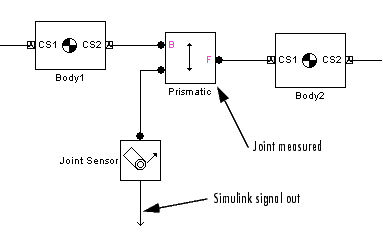

| SimMechanics |   |
Measure the motion and force/torque of a joint primitive
Library
Description
The Joint Sensor block measures the position, velocity, and/or acceleration of a joint primitive in a Joint block.
The Joint Sensor measures the motion along/about the joint axis (or about the pivot point for a spherical primitive) in the reference coordinate system (CS) specified for that joint primitive in the Joint's dialog box. The Joint connects a base and a follower Body. The base-follower sequence determines the sense of the motion.
Depending on the joint primitive being sensed, you measure one of these motion types:
The input is the Connector Port connected to the Joint being sensed. The outport is a set of Simulink signals or one bundled Simulink signal of the position, velocity, and/or acceleration of the joint primitive.
A Joint Sensor block measures one joint primitive at a time:
Dialog Box and Parameters
The dialog box has one active area, Measurements.
Measurements
Unknown.Here is a Joint Sensor connected to a Prismatic that connects two Bodies:

You must add an Sensor port (Connector Port) to the Joint block to connect the Joint Sensor to it. The base (B)-follower (F) Body sequence on the two sides of the Joint determines the sense of the Joint Sensor data.
The Measurements pane you see in the Joint Sensor dialog depends on the type of joint primitive to which you connect the Joint Sensor.
Base or Follower. The default is Base. Also choose With respect to coordinate system for the reaction torque and/or force. The default is Absolute (World).m (meters), m/s (meters/second), m/s2 (meters/second2), N (Newtons), and N-m (Newton-meters), respectively, for Position, Velocity, Acceleration, Force, and Torque.The bundled Simulink output signal for a prismatic primitive has these measurements ordered in a row vector. Unselected components are removed from the vector signal:
| Position |
Velocity |
Acceleration |
Computed Force |
Reaction Torque (3-vector) |
Reaction Force (3-vector) |
Base or Follower. The default is Base. Also choose With respect to coordinate system for the reaction torque and/or force. The default is Absolute (World).m (meters), m/s (meters/second), m/s2 (meters/second2), N (Newtons), and N-m (Newton-meters), respectively, for Position, Velocity, Acceleration, Force, and Torque.Note
The absolute angle of revolute motion is mapped on to the interval (-180o, +180o] degrees or (- ,+ ,+ ] radians. ] radians.
|
The bundled Simulink output signal for a revolute primitive has these measurements ordered in a row vector. Unselected components are removed from the vector signal:
| Angle |
Angular Velocity |
Angular Acceleration |
Computed Torque |
Reaction Force (3-vector) |
Reaction Torque (3-vector) |
Base or Follower. The default is Base. Also choose With respect to coordinate system for the reaction torque and/or force. The default is Absolute (World).The bundled Simulink output signal for a spherical primitive has these quaternion measurements ordered into a larger row vector. Unselected components are removed from the vector signal:
| Quaternion (4-vector) |
Quaternion, derivative (4-vector) |
Quaternion, second derivative (4-vector) |
Reaction Torque (3-vector) |
Reaction Force (3-vector) |
See Also
Body Sensor, Constraint & Driver Sensor, Joint Actuator, Joint Initial Condition Actuator, Joint Stiction Actuator, Prismatic, Revolute, Spherical
See Creating Joints.
In Simulink, see the Signal Routing Library and the Sinks Library.
 | Joint Initial Condition Actuator | Joint Stiction Actuator |  |